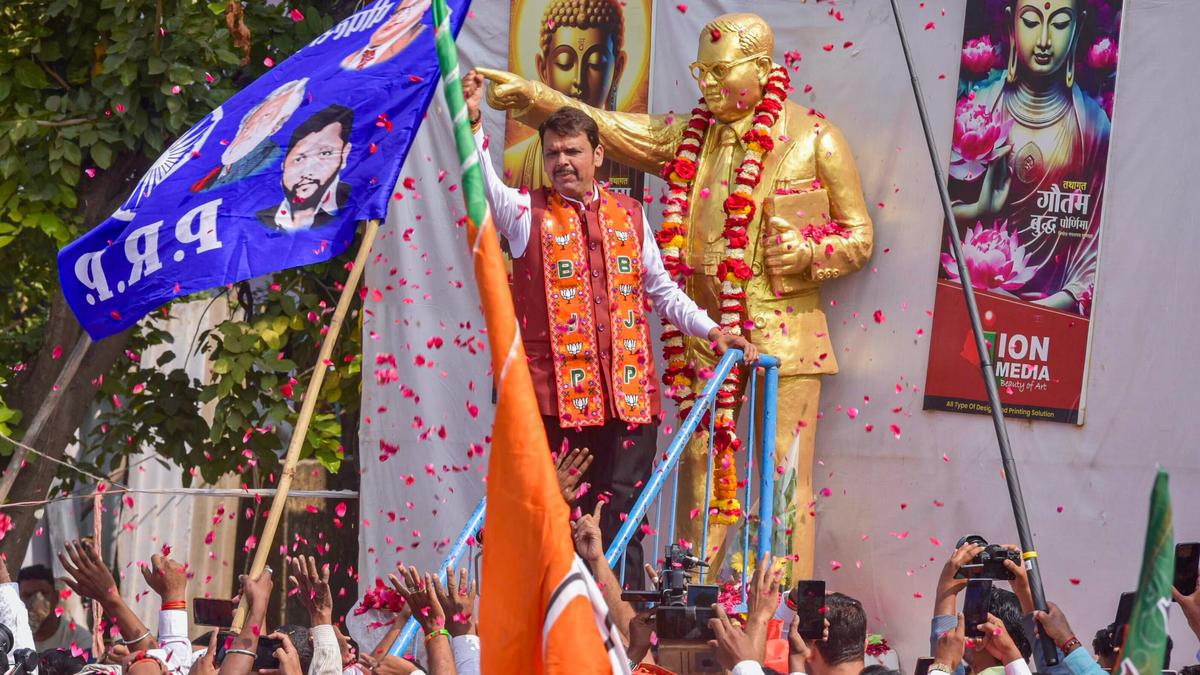
Why is Maharashtra poll fray fragmented?
The Hindu
Maharashtra's complex politics involve caste dynamics, regional disparities, and shifting alliances, impacting electoral outcomes and governance strategies.
Since the formation of the State in 1960, Maharashtra has been dominated for a long period by the Congress System, stitching a cross-sectional alliance between the dominant agrarian caste of the Maratha-Kunbi group and effective support from Dalits and Muslims. Scholars have also used the term “bahujan politics” to describe this kind of cross-sectional alliance first orchestrated by veteran Congress leader Y.B. Chavan. The electoral success of this political mobilisation meant that successive Congress Chief Ministers also tried to replicate their own versions of this model to ensure the continuance of Congress rule in the State. However, the emergence of the Bharatiya Janata Party (BJP) and Shiv Sena, in alliance with each other, introduced new dimensions to the political arena in the 1990s, emphasising Hindutva and regional pride. This altered the electoral dynamics and political discourse of the State, especially at a time when agricultural growth had stagnated and the economy was adapting to a transition to rapid industrial growth amidst privatisation.
Caste plays a pivotal role in Maharashtra politics despite claims of progressive social movements and rapid economic growth, both of which were expected to make caste obsolete in the social milieu. The dominant caste position is enjoyed by Marathas, who not only have a high numerical presence but, when disaggregated into Maratha-Kunbis, are also geographically spread and control levers of economic power by owning land and extensive networks of sugar cooperatives and control over local governance structures. The Marathas have also legitimised their position as the dominant caste through their historical association and lineage from Chhatrapati Shivaji Maharaj, who is one of the most influential historical personalities to have impacted the thought behind a Maharashtrian identity, more so than Ambedkar or Jyotiba Phule to some extent.
Historically speaking, Brahmins of the State have also exerted disproportionate influence over political power; however, the politics of modern Maharashtra have largely been organised around the idea of non-Brahmin mobilisations, which is even visible in the discomfort among certain political classes to accept the leadership of Brahmin politicians like Manohar Joshi in the past or Devendra Fadnavis in the more contemporary scenario. The Other Backward Classes (OBCs), including communities like the Malis, Dhangars, and Vanjaris, have been mobilised by parties like the BJP to counterbalance Maratha hegemony. Leaders like Gopinath Munde have been instrumental in consolidating OBC support for the BJP, reshaping electoral dynamics by successfully replicating some of the tested models of local patronage networks of cooperatives used by the Maratha leadership to develop his own political constituency in Beed and adjoining districts.
Dalit politics is also significant, with communities like the Mahars (Navayana Buddhists, also called Nav Baudh) asserting their influence, particularly in regions like Vidarbha. Parties like the Republican Party of India (Athawale) and the Vanchit Bahujan Aghadi (VBA) seek to represent Dalit interests, often impacting electoral outcomes in key constituencies, as their electoral impact is largely localised to a few pockets in suburban Mumbai-Thane and Akola, although their political impact ensures that issues of Dalit interest are not completely sidelined by other political parties.
Regional disparities further complicate the political landscape. For instance, Vidarbha’s agrarian distress and demand for separate statehood influence its political leanings, while Mumbai-Thane’s urban issues and cosmopolitan demographics create different priorities. The Konkan region’s unique socio-cultural fabric adds another layer of complexity.
Shifting dynamics of State politics are easy to identify by looking at the changing dynamics of party competition within these different sub-regions, where each region sees the dominance of different parties at different points in time. For example, Vidarbha, which sends 62 MLAs to the assembly, sees a close contest between the BJP and Congress. Traditionally seen as a Congress bastion, it was also the region where the BJP started its expansion in the State, and much of the BJP’s state-level leadership comes from this region — a testimony to the importance of Vidarbha in the BJP’s expansion in Maharashtra. Western Maharashtra is usually dominated by cooperative society barons who have comfortably switched between Congress and NCP to continue their hold over these rural networks of power. The BJP’s emergence as a key stakeholder in the politics of the region has depended on the party’s ability to co-opt many of these sugar and education barons into their own party fold. The Konkan and Mumbai region have seen the Shiv Sena as a dominant political force for a long time with steady expansion in the Marathwada region, especially in the wake of the Namantar movement. However, BJP, Congress, and NCP have also created pockets of influence in different parts of Marathwada, mostly by co-opting the local dominant political elites rather than building their own cadre base in new areas of expansion.
It is the supremacy of these local political elites in different parts of the State, substituting grassroots party organisation with their own networks of faction supporters, that makes politics in Maharashtra so hyper-localised, even if the discourse is largely centred around state-wide issues.





















 Run 3 Space | Play Space Running Game
Run 3 Space | Play Space Running Game Traffic Jam 3D | Online Racing Game
Traffic Jam 3D | Online Racing Game Duck Hunt | Play Old Classic Game
Duck Hunt | Play Old Classic Game











